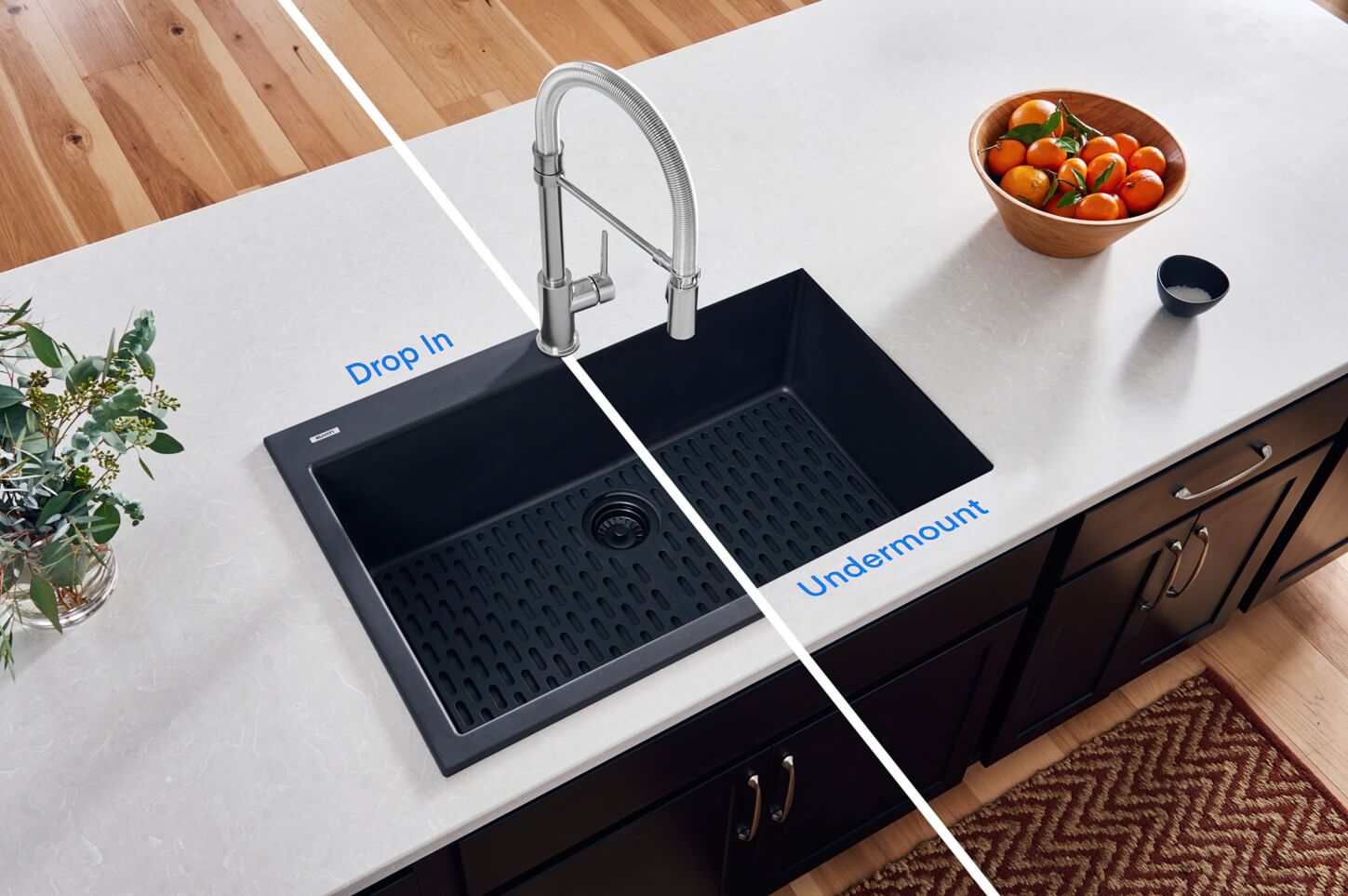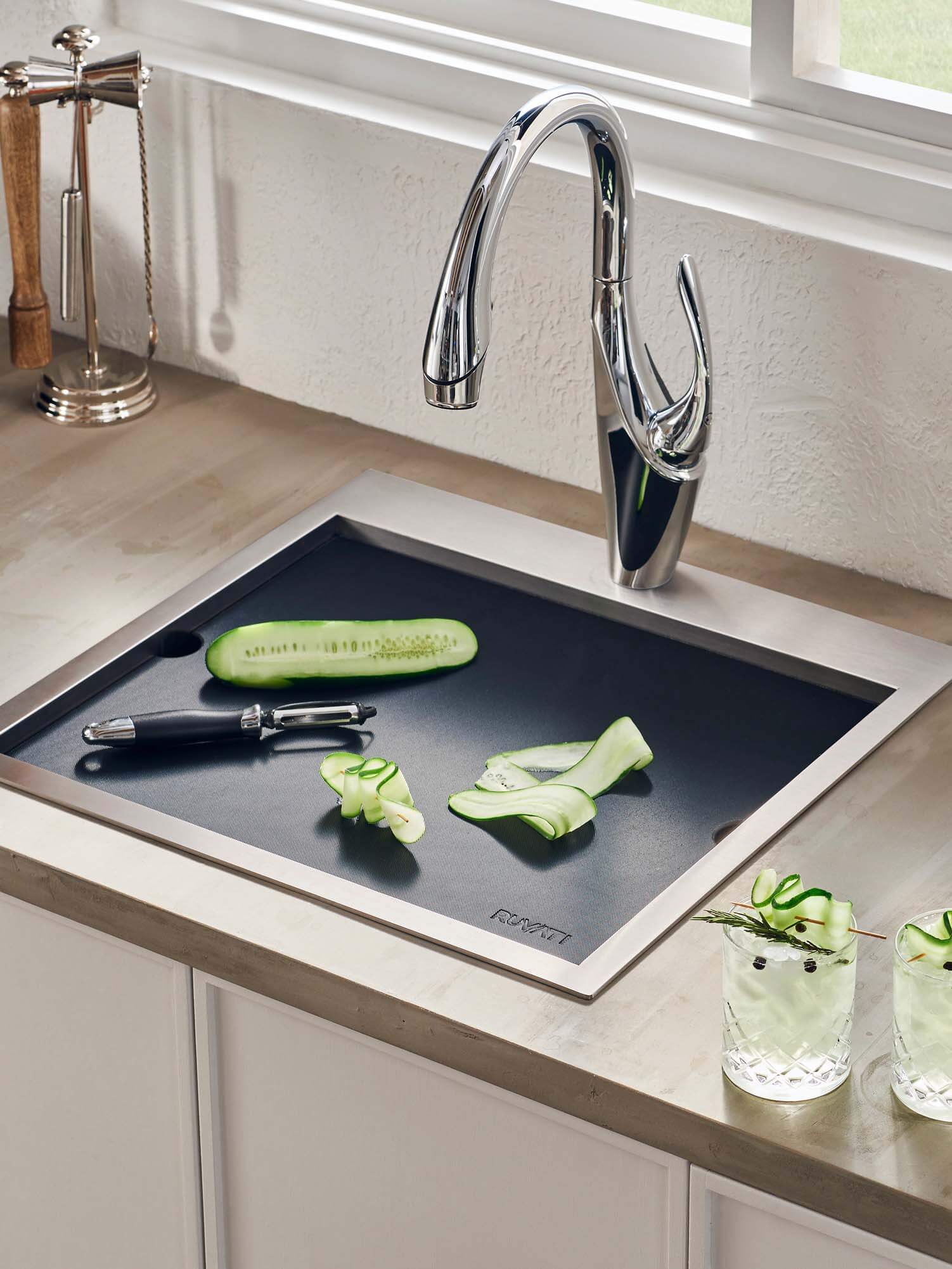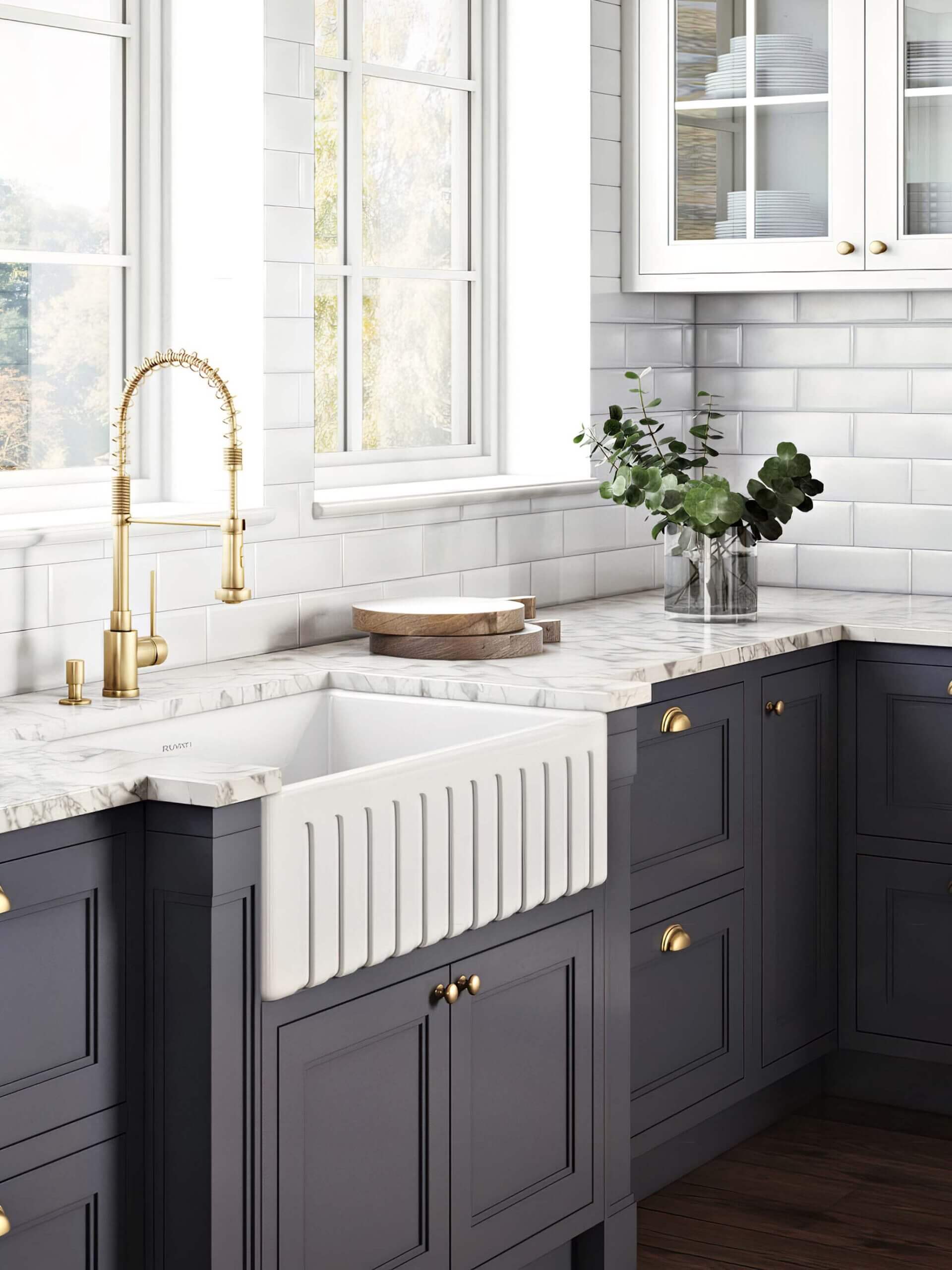Are you considering a new sink? Perhaps you’ve seen the terms under mount or drop in, but what does it even mean? Choosing the right sink is like selecting the perfect accessory to complement your outfit. There are infinite combinations of colors, materials, sizes, and more. The least complicated choice of them all is the installation type. Everything else comes down to personal preference as well as space. You shouldn’t get bogged down in the process of remodeling your kitchen. It should enhance the overall aesthetic and provide practicality and ease of use. At Ruvati, we like to keep things simple, and we’ve put together this guide to do just that. We’ll explore the pros and cons of undermount and drop-in kitchen sinks, shedding light on the key factors to consider. So, whether you’re looking for a sleek and seamless under-mount sink or a versatile and easy-to-install drop in sink, you’ll have the necessary insights into the advantages and disadvantages of each option.
Sink Features: Undermount vs Drop-In Sink
| Aspect | Undermount | Drop-in |
|---|---|---|
| Installation Method | Installed underneath the countertop with special clips | Installed by resting the sink into a hole with a rim |
| Design Options | Creates a seamless flow from counter to sink | It provides a visible rim or lip that rests on the countertop |
| Maintenance Requirements | Easier cleaning due to no gap underneath | It requires a little extra for cleaning visible seams |
| Counter Space | Maximizes counter real estate | Takes up more counter space due to the visible rim |
| Surface Compatibility | It cannot be installed on all surfaces | Suitable for various surfaces |
| Cleaning Ease | Cleaning crumbs and spills directly into the sink is easier due to the lack of an edge | Cleaning around the raised edge will require extra effort |
| Resale Value | Contributes to a high-end and custom look | It does not increase resale value as much |
| Cost | It may be more expensive due to the precision installation | Typically less expensive, suitable for budget |
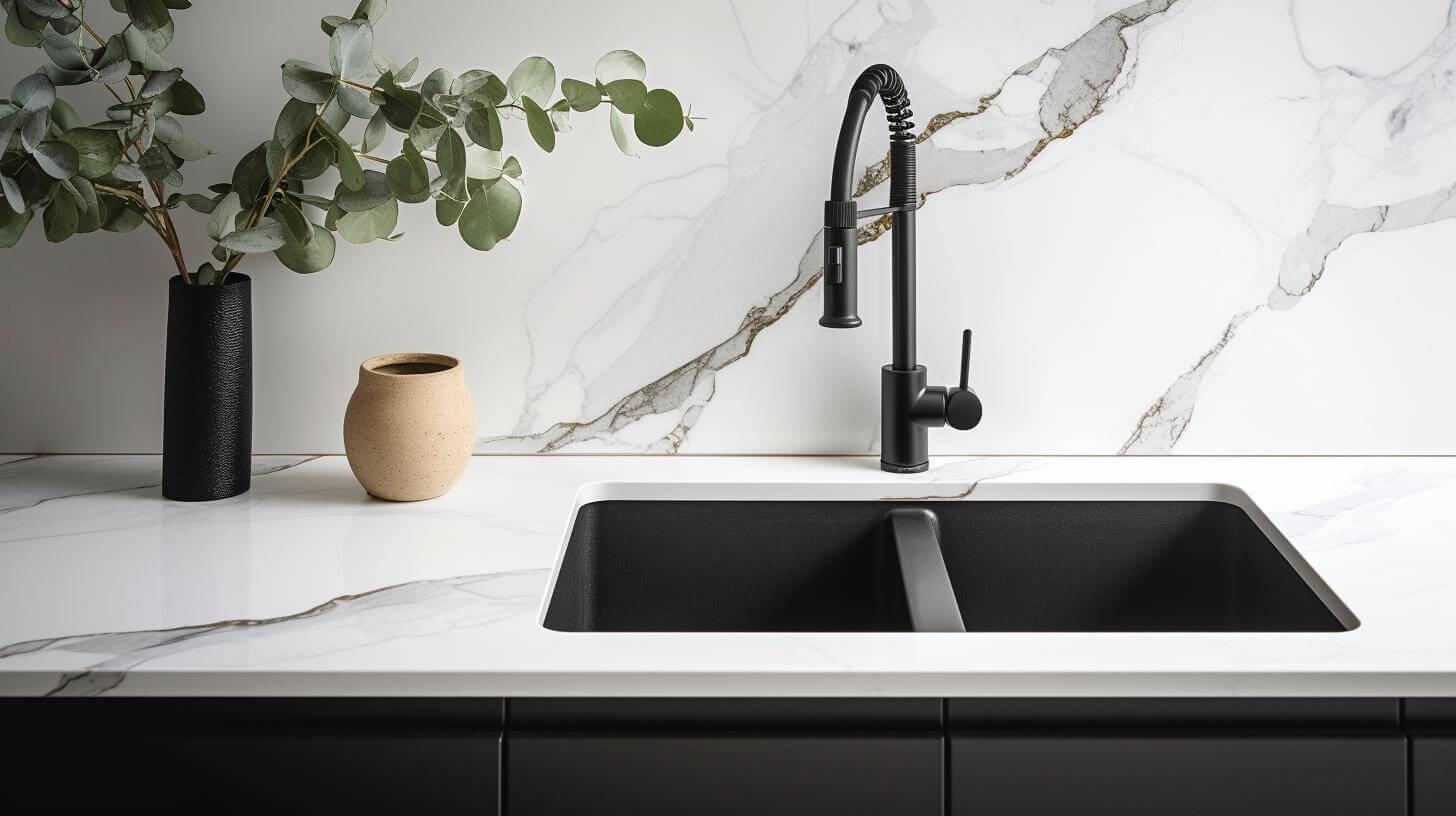
What is an Undermount Sink?
An undermount sink is a type of sink that is installed beneath the countertop. The rim of the sink or lip protrudes above the surface. It is typically mounted from underneath, creating a seamless and sleek look. Although undermount sinks require special attention during installation, they are often favored for their clean and modern appearance. This installation type does not disrupt your countertop’s aesthetics.
Pros
Undermount sinks offer numerous advantages, making them popular in modern kitchens. Here are three reasons why you should consider an undermount sink for your kitchen:
Streamlined and Modern Look: Unlike drop-in sinks, undermount kitchen sinks don’t rest on top of the counter. They are installed underneath the countertop, creating a seamless and sleek appearance. This design choice enhances the overall style of your kitchen, giving it a sophisticated and contemporary feel.
Easy Maintenance: With no rim or crevice to catch dirt, undermount sinks are easy to clean. You can brush crumbs or wipe spills directly into the sink without any obstructions. This streamlined design also makes it easier to keep your countertop clean, as there is no lip to collect grime.
Versatile Faucet Placement: Undermount sinks allow for flexible faucet placement options. You can install the faucet behind the sink or on the wall, giving you more freedom to customize your kitchen.
Cons
Installing an undermount sink can present challenges and drawbacks compared to other sink types. While there are many advantages to choosing an undermount sink, it’s important to consider the cons as well. One of the main disadvantages is that undermount sinks are often harder to install. They require professional installation for proper fit and sealing, which can increase the overall cost. Undermount sinks don’t just float under our countertop; the sink is installed with mounting clips, which may be difficult to attach to laminate surfaces. Additionally, undermount sinks are often more expensive than drop-in sinks, making them less budget-friendly. They also require a waterproof countertop material, such as a solid surface or granite, to prevent water damage. Lastly, undermount sinks could require more bending to work in the sink due to their lower sink basin height.
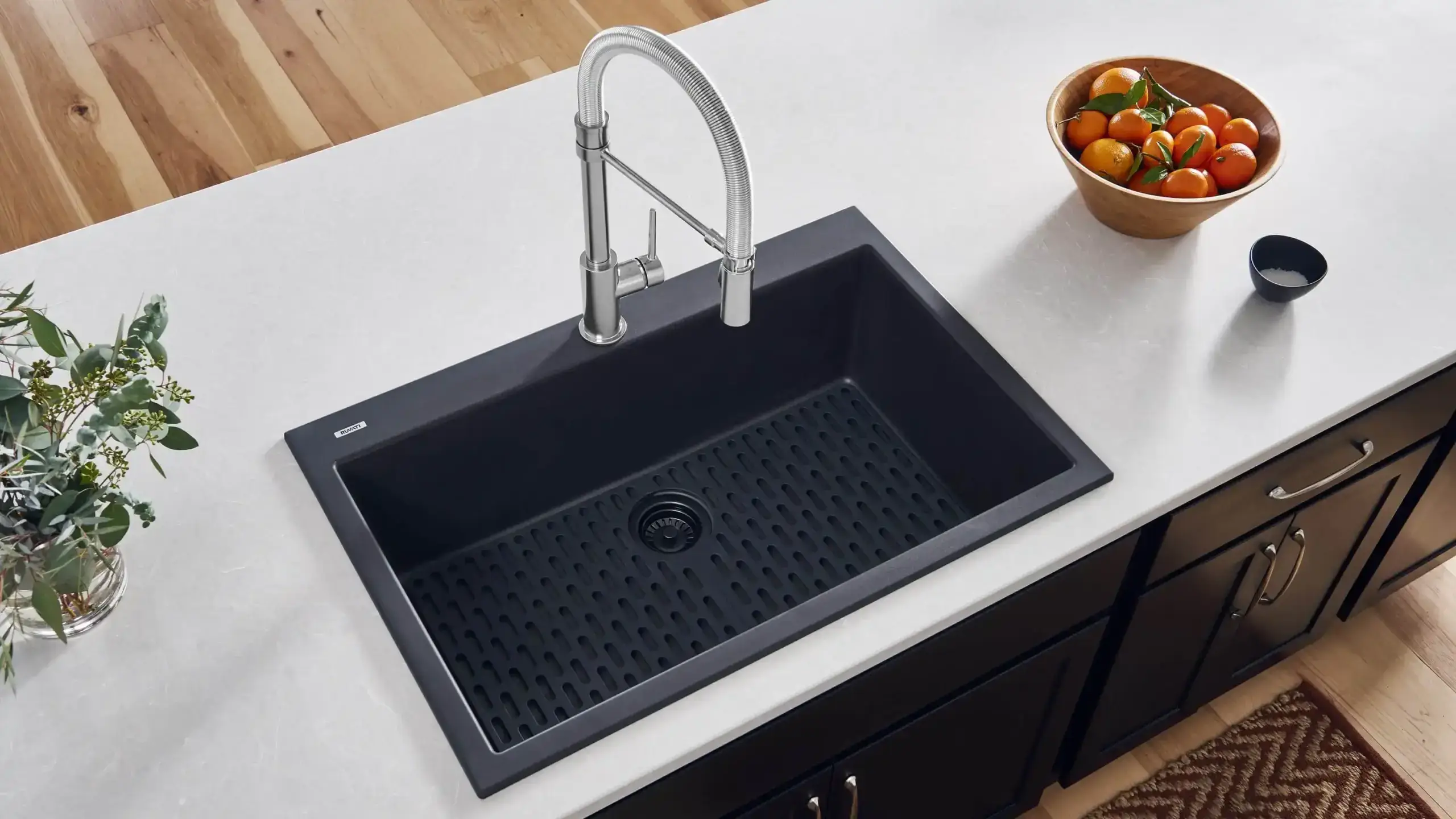
What is a Drop-in Sink?
A drop-in sink is a type of sink that is placed on top of the countertop, with a visible rim or lip that rests on the surface. It is easy to install and can be a DIY project, making it a popular choice for homeowners. However, drop-in sinks may take up more counter space and require more cleaning than undermount sinks.
Pros
For those looking for a simpler and more accessible sink installation option, a drop-in sink offers a convenient solution. Here are the pros of choosing a drop-in sink for your kitchen:
Easy Installation: Drop-in sinks are designed to be easy to install, making them a popular choice for DIY projects. They can be placed on top of the countertop and secured with clips, eliminating the need for professional installation.
Versatility: Drop-in sinks suit all countertop materials, including quartz and tile. This flexibility lets you choose the sink material that best suits your kitchen design and preferences.
Affordable Option: Drop-in sinks are generally more affordable than undermount sinks, making them a budget-friendly choice for homeowners. They come in a wide range of prices, allowing you to find a sink that fits your budget without compromising on style or quality.
Cons
Installing an undermount sink can present challenges and drawbacks compared to other sink types. While there are many advantages to choosing an undermount sink, it’s important to consider the cons as well. One of the main disadvantages is that undermount sinks are often harder to install. They require professional installation for proper fit and sealing, which can increase the overall cost. Undermount sinks don’t just float under our countertop; the sink is installed with mounting clips, which may be difficult to attach to laminate surfaces. Additionally, undermount sinks are often more expensive than drop-in sinks, making them less budget-friendly. They also require a waterproof countertop material, such as a solid surface or granite, to prevent water damage. Lastly, undermount sinks could require more bending to work in the sink due to their lower sink basin height.

Kitchen Sink Material Comparison
Now, let’s compare kitchen sinks to help you make the best decision for your space. We’ll explore the aesthetics and countertop compatibility of different sink types and the cleaning and maintenance considerations. Additionally, we’ll discuss the installation process for both sink styles, cost analysis, and the potential impact on home value. Considering these points, you’ll be well-equipped to choose the right sink for your kitchen.
Sink Aesthetics and Countertop Compatibility
When comparing kitchen sink options, it is important to consider the aesthetics and compatibility with your countertop. Here are three key factors to consider when it comes to sink aesthetics and countertop compatibility:
Undermount Sink vs Drop-in Sink: The choice between an undermount sink and a drop-in sink can greatly impact the overall look of your kitchen. An undermount sink creates a seamless flow from the counter to the sink, giving it a sleek and modern appearance. On the other hand, a drop-in sink is more visible and can add a traditional or farmhouse-style touch to your kitchen.
Sink Material and Countertop Compatibility: Different sink materials work better with certain surfaces. For example, stainless steel sinks are versatile and can complement various materials, while ceramic sinks are better suited for solid slab countertops. It is important to consider the sink and kitchen surfaces’ durability, maintenance, and aesthetic appeal.
Pros and Cons: Each sink type has pros and cons regarding aesthetics and countertop compatibility. Undermount sinks offer a seamless look but may require professional installation and may not be suitable for all surfaces. Drop-in sinks are a no-fuss install and work well with various countertops but may take up more space due to the visible rim. Consider these factors when making your decision.
Sink Cleaning and Maintenance
To keep your kitchen sink clean and well-maintained, it is important to understand the differences in cleaning and maintenance between undermount and drop-in sinks. Undermount sinks have a seamless design with no visible rim, making them easier to clean as there are no crevices for food particles to get trapped. However, the gap between the sink and countertop in undermount sinks can collect food buildup, requiring the caulk to be replaced every three to five years. On the other hand, drop-in sinks provide better access and visibility for cleaning. Still, the visible seam formed by the lip and countertop can collect gunk, requiring more cleaning effort compared to undermount sinks.
Drop-in vs Undermount Installation Guide
Considering the cleaning and maintenance differences between undermount and drop-in sinks, it’s time to explore the installation guide for both options to help you make an informed decision. Consider these factors when choosing the best installation method for your needs and style preferences. Here are three key points to consider:
| Sink Installation: Pros & Cons | Undermount | Drop-In |
|---|---|---|
|
|
|
Consider these factors when choosing the best installation method for your needs and style preferences.
Resale Value Impact
The choice of kitchen sink can significantly impact the pre-owned value of your home. When considering the depreciation value impact of undermount vs drop-in sinks, it’s important to keep the following factors in mind:
Luxurious and high-end appeal: Undermount sinks have a sleek and seamless appearance that adds a touch of sophistication to any kitchen. This luxurious look can increase the overall value of your home, especially for potential buyers looking for a high-end and custom look.
Common and standard appearance: On the other hand, drop-in sinks might have a more standard and common appearance. While they are still functional and practical, the lack of a seamless design can affect the perceived value of your kitchen.
Cost difference: Ultimately, the difference between undermount and drop-in sinks is insignificant in decision-making. Therefore, when considering the impact of depreciation, it’s more important to focus on the overall aesthetic and appeal of the sink.
Conclusion
In conclusion, when deciding between an undermount or drop-in sink, it ultimately comes down to personal preference and the specific needs of your kitchen or bathroom. Undermount sinks offer a seamless and sophisticated look, while drop-in sinks provide versatility and easy installation. Consider factors such as aesthetics, countertop compatibility, cleaning considerations, and cost before making your decision. Whether you choose a stainless steel undermount sink or a versatile drop-in sink, both options can enhance the functionality and style of your space.

